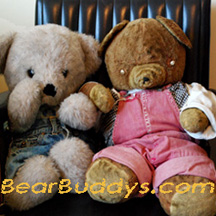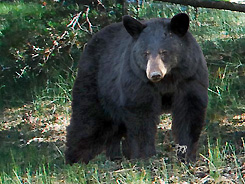

Home Toy Bears Nature Bears Mythical Bears Historical Bears Bear Friends Resources

BLACK BEAR
 Black Bears populate the North Amercan, European and Asian continents,
with fairly closely related species, smaller and generally more common
than Brown bears. Black Bears are omnivores, with diets varying depending
on the season. Black bears usually live in largely forested areas,
but do leave the forests in search of food, sometimes attracted to
human communities because of the availability of food and, especially
disposed of in trash. Black bears are very dexterous and clever, capable
of opening screw-top jars and manipulating door latches.
Black Bears populate the North Amercan, European and Asian continents,
with fairly closely related species, smaller and generally more common
than Brown bears. Black Bears are omnivores, with diets varying depending
on the season. Black bears usually live in largely forested areas,
but do leave the forests in search of food, sometimes attracted to
human communities because of the availability of food and, especially
disposed of in trash. Black bears are very dexterous and clever, capable
of opening screw-top jars and manipulating door latches.
Despite the name, not all Black Bears have black fur, for instance,
the majority Black Bears in Yosemite National Park and the surroundng
California Sierra Forests are brown. Individual coat coloration can
range from blond, light brown to dark chocolate brown, cinnamon, to
jet black, with many variations. Bluish tinged black bears can be found
along the coasts of Alaska and British Columbia. White to cream colored
black bears occur in coastal islands and the adjacent mainland of southwest
British Columbia. Black bears can be distinguished from brown bears
by their smaller size, more concave facial profiles, shorter claws
and the lack of a shoulder hump, many species may develop a white “crescent
moon” mark on the chest is common in Eurasia, but only a quarter
of the Black Bears in North America. Black Bears on the East Coast
on the United States tend to be heavier on average than those on the
West Coast. Adult males typically weigh between 125 to 550 lb, while
females weigh a third less less at 90–275 lb.
Black Bears are territorial, marking their range by rubbing their bodies
against trees and clawing at the bark. Black bears are excellent and
strong swimmers and climb trees to feed, escape enemies or to hibernate.
Viewed as not acutely dangerous to humans, rarely attacking when confronted,
more often making mock charges, emitting blowing growl noises and swatting
the ground with their forepaws, though they have been responsible for
a few deaths, as well as occasional property damage and livestock kills.
The majority of attacks happen in national parks, usually near campgrounds,
when cornered or startled, or being attracted by human feeding. Unlike
grizzlies, female black bears do not display the same level of protectiveness
to their cubs, and rarely attack humans in their vicinity. Black Bears
do not truly hibernate, but become less active during the winter months.
Mother bear litters usually consist of 2 cubs, though litters of 6
have been recorded. They reach sexual maturity at the age of three
years, and attain their full growth at 5 years. The average lifespan
of Balack Bears in the wild is 18 years with the oldest recorded wild
was 31 years, but in captivity a bear lived to 44. Black bears tend
to escape competition from brown bears by being more active in the
daytime, and living in more densely forested areas. Up to 85% of the
black bear's diet consists of vegetation and bugs, bees and wasps,
though they tend to dig less than brown bears, eating far fewer roots,
bulbs, and tubers than brown bears. Black bears will fish for salmon
during the night, as their black fur is easily spotted by salmon in
the daytime. Black bears often drag their prey to cover, preferring
to feed in seclusion. They will compete with cougers for prey, steeling
it, and sometime steal prey from human animal traps or hunters.
Black bear
cubs inspired the creation of the Teddy
Bear, Winnie-The-Poo
and Smokey Bear
©2010 WLEV BearBuddys.com